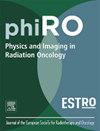fapi -正电子发射断层扫描在头颈癌放疗中的应用及未来方向
IF 3.4
Q2 ONCOLOGY
引用次数: 0
摘要
放疗是头颈部鳞状细胞癌(HNSCC)治疗的基石。成像在靶区划定中起着重要的作用,一方面是为了获得足够的靶剂量,另一方面是为了限制辐射对周围健康组织的毒性。成像技术的进步,包括正电子发射断层扫描(PET)的功能成像,提高了准确的靶标描绘,允许适应性放疗,并改进了反应评估。本文探讨了成纤维细胞活化蛋白抑制剂(FAPI)-PET/CT在HNSCC放疗计划中的潜在作用,并将其与目前标准的氟-18氟脱氧葡萄糖(18F-FDG) PET/CT的疗效进行了比较。FAPI-PET/CT是一种新兴的成像方式,用于预处理成像可以增加病变的检测,特别是在颅底附近。FAPI PET/CT可提高肿瘤描绘的特异性,特别是在区分肿瘤组织和正常组织方面。目前的证据表明,FAPI-PET增加了GTV体积,但这是否代表更准确的肿瘤描绘或高估仍不清楚。对于治疗后的反应监测,在头颈癌中尚无证据,但对于直肠癌,FAPI-PET/CT在新辅助放疗后残留病变的检测中显示出令人鼓舞的结果。目前,FAPI-PET/CT可作为辅助成像,不应替代其他成像方式。迫切需要前瞻性验证研究来确定FAPI-PET对放疗计划和反应监测的临床影响。本文章由计算机程序翻译,如有差异,请以英文原文为准。
FAPI-positron emission tomography for radiotherapy in head and neck cancer: applications and future directions
Radiotherapy is a cornerstone in the treatment of head and neck squamous cell carcinoma (HNSCC). Imaging plays an important role in target delineation in order to achieve adequate target dose and on the other hand limit radiation-induced toxicity to surrounding healthy tissues. Advancements in imaging techniques, including functional imaging with positron emission tomography (PET), have improved accurate target delineation, allowed for adaptive radiotherapy, and improved response evaluation.
This review explores the potential role of fibroblast activation protein inhibitor (FAPI)-PET/CT in radiotherapy planning for HNSCC, comparing its efficacy to the current standard, fluorine-18 fluorodeoxyglucose (18F-FDG) PET/CT.
FAPI-PET/CT is an emerging imaging modality that for pretreatment imaging may increase lesion detection, especially near the skull base. For target delineation FAPI PET/CT may enhance the specificity of tumor delineation, particularly in distinguishing tumor tissue from normal tissue. Current evidence suggests that FAPI-PET increases the GTV volume, but whether this represents more accurate tumor delineation or overestimation remains unclear. For response monitoring after treatment, there is no evidence in head and neck cancer, but for rectal cancer FAPI-PET/CT showed promising results in detection of residual disease after neo-adjuvant radiotherapy.
For now, FAPI-PET/CT could be used as additional imaging, and should not be used as replacement for other imaging modalities. There is an urgent need for prospective validation studies to determine the clinical impact of FAPI-PET on radiotherapy planning and response monitoring.
求助全文
通过发布文献求助,成功后即可免费获取论文全文。
去求助
来源期刊

Physics and Imaging in Radiation Oncology
Physics and Astronomy-Radiation
CiteScore
5.30
自引率
18.90%
发文量
93
审稿时长
6 weeks
 求助内容:
求助内容: 应助结果提醒方式:
应助结果提醒方式:


